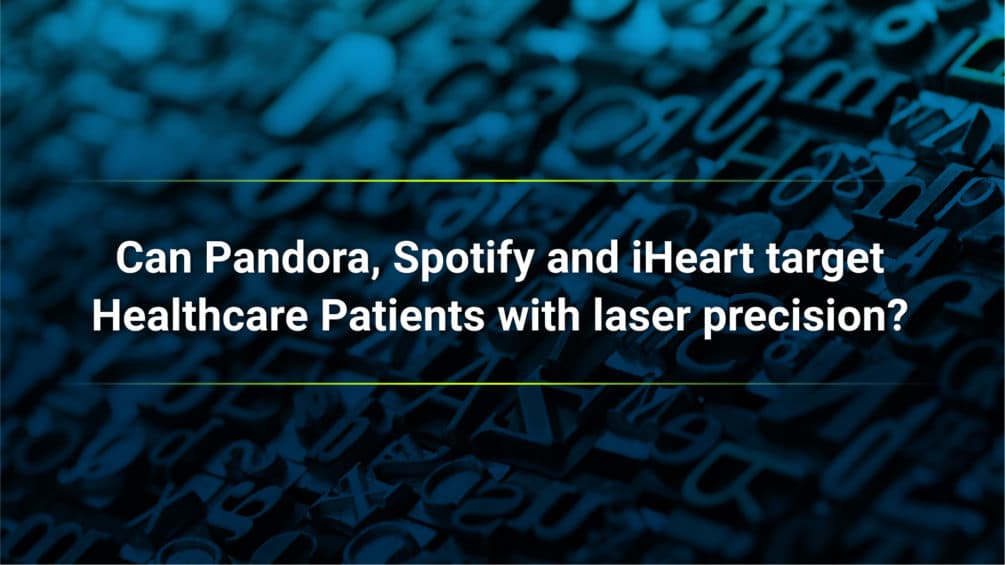Can Pandora, Spotify and iHeart target Healthcare Patients with laser precision?
If you haven’t considered for , it’s time to put it on your list. The big players include Pandora, Spotify, and iHeart. They deliver both music and talk, streaming and on demand across a wide range of interactive channels.
As mobile devices have proliferated, so, too has digital audio. It reaches at least 64 percent of the population each month, for a total of over 180 million consumers. Every age group uses it and will get your message, even when they’re away from their screens. Since most cars integrate digital audio, its use is also growing on the highways. But the most recent game changer is the smart speaker, which has brought audio content back into the home.
With every imaginable flavor of music, news, commentary and podcast content, digital audio is on the cusp of becoming what terrestrial radio once was – omnipresent.
Laser audience targeting for better efficiency
What separates digital audio from its traditional ancestors is the data. Most listeners on Pandora, Spotify and iHeart Radio choose the ‘free’ version of the more popular services, which exposes them to ads. Like banner and social advertising, digital audio is programmatic advertising; the marketing message can be delivered on almost an individual basis – targeted to granular attributes and demographics within narrow audience segments.
Buyers have access to sophisticated intelligence to mine key listener attributes – demographics, purchasing patterns and other interests. Advertisers can target by predicted political affiliation, mobile platform, auto make and model – and both past and future healthcare consumption.
How healthcare fits in
Healthcare marketers have the opportunity to hyper-target listeners. According to its presentation Engagement Redefined: Engaging and Healing Through the Power of Music, Pandora has finely honed the craft of accurately categorizing listeners based on their tastes in music. Partnering with third-party aggregators, Pandora adds healthcare attributes, including:
- Adult listeners likely to be caring for elderly relatives.
- How often the listener is likely to visit clinics, urgent care centers and the emergency room and likely used physical therapy, chiropractic and other forms of specialty care.
- Predictive characteristics, like targeting flu vaccine messaging to those most at risk; joint replacement to older listeners; pediatric care to new parents; and cardiac care to those with elevated risk.
(To learn more about Pandora's targeting in healthcare and pharma, see this article on FiercePharma.com.)
Since the targeting is largely predictive and built on artificial intelligence and advanced cybersecurity techniques, this kind of granular analysis can be accomplished without compromising the privacy of any individual’s health data.
All the major players use data in similar ways, giving healthcare marketers a myriad of options to drive traffic to their service lines. As the sophistication level of the intelligence rises, cost per impression falls, driving new levels of advertising efficiency for healthcare marketers seeking to reach healthcare patient audiences.
Data also drives better reporting, with built-in metrics to track ads served, clickthrough, reach and additional audience attributes. The major players aggregate data in real time, so there is little wait time for reporting.
Terrestrial radio, too
Since it’s driven by machine intelligence (e.g., machine learning), programmatic media buying is faster, more efficient and less prone to human error and bias than the traditional back-and-forth RFP and negotiation model of years past.
That power is driving innovation in traditional broadcasting. Like other industries that predate Web technology, terrestrial radio stations are leveraging data and automation to deliver both better targeting and more reliable media buying.
The actual media purchased remains traditional, for the most part. But planning, targeting and making the buy are achieved through digital platforms, powered by aggregate listener demographics and purchase habits. Some services also offer combined buys, incorporating both traditional and digital content.
Terrestrial radio still has enormous reach. By leveraging data in the buying cycle, programmatic buying combines that reach with many of the targeting benefits of digital media. The concept will likely grow and its data become more accurate over time, since traditional listeners are increasingly consuming broadcast content over digital devices.
Navigating a challenging marketing landscape
Although potential rewards are handsome, challenges remain. The programmatic audio market is growing by leaps and bounds, worth more than $100 million per year. With that much potential income on the table, the industry is experiencing a lot of churn. Programmers, buyers and aggregators are merging, forging partnerships and buying one another out. The marketplace is some time away from stability and effective buying can be tricky.
Hyper-targeting listeners is also putting new demands on creative. Since listeners expect custom content in programming, they are easily annoyed when the creative clashes. Successful digital audio advertisers embrace the concept of dynamic creative – tailoring messaging both to listener demographics and in the right style for the channel and format they’re listening to.
With so many tools and moving parts in the mix, managing digital audio on your own would likely end in a lot of time spent for little satisfaction. Working with an expert who knows the ropes will help you maximize the potential of the new technology, smooth the learning curve and get your message into the ears of exactly the consumers who need to hear it.
To get started leveraging digital audio for your goals, contact the digital marketing experts at Healthcare Success or call 800-656-0907.








